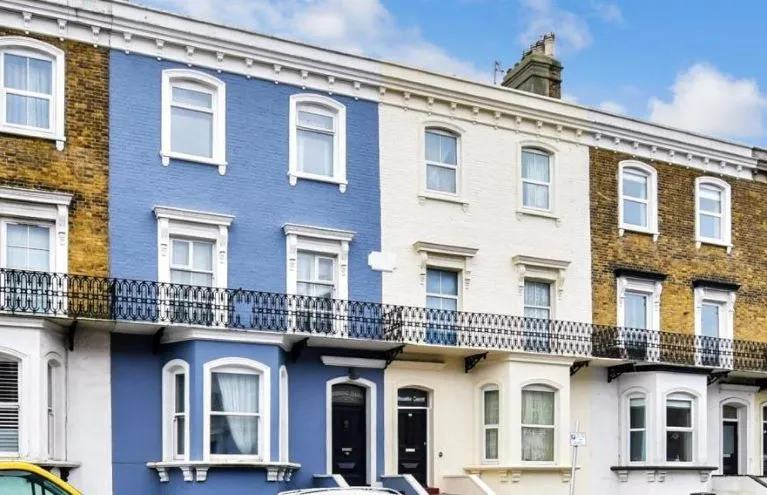
- Estate agents and new figures reveal that buy-to-let may be losing its appeal
Buy-to-let landlords are heading for the exit, says estate agents, as higher mortgage rates, tightened regulation and unfavourable tax changes encourage more to sell up.
There have been 1.53million property sales made by landlords since the start of 2016, according to property firm Hamptons, compared to 1.22million purchases during that time.
This comes ahead of another potential tax hike for property investors, with rumours that Labour will raise capital gains tax in its October Budget.

The rush to the exit adds up to a net loss of more than 300,000 rental homes over the past eight years.
Some investment companies are filling the void, with pension funds and insurance companies partnering with house builders and developers to build large-scale rental home developments, known in the industry as build-to-rent.
However, according to the property firm, Savills, there have only been 106,000 build-to-rent homes completed since June 2016 – not nearly enough to fill the gap left behind by landlords.
The number of properties available to rent across the UK is down by a quarter since 2019, according to consultancy firm TwentyCi.
It says available properties to rent are at the lowest level since it began recording data 15 years ago.
While the data isn’t yet showing an uptick this year in landlords selling up, members of the Royal Institute of Chartered Surveyors (Rics) are suggesting this is very much the case.
Robert John Newton-Howes of Yorkshire Surveyors Limited in Huddersfield says: ‘There is increasing evidence of landlords exiting the market, which accounts for a large proportion of new sales instructions.’
Martin Allen of Elgars estate agents in Canterbury, Kent adds: ‘Yet more landlords wanting to regain possession to sell or selling upon tenants leaving rather than reletting.’
Howard Davis, managing director of Howard estate agents says they are also seeing a similar trend playing out in Bristol.
‘A steady increase of landlords selling all or part of their portfolios,’ added Davis in the latest Rics Survey.
Some Rics members point to the Government’s plans for a Renters Rights Bill to end Section 21 ‘no-fault’ evictions as a final straw for some landlords.
The end of no-fault evictions is likely to be introduced alongside other parts of the previous Government’s Renters Reform Bill.
This will probably include giving tenants the ability to challenge rent increases and the ending of bidding wars.
It will introduce the same decent homes standard that applies in the social housing sector and also ensure landlords don’t discriminate against tenants in receipt of housing benefits or with pets or children.

John Chappell of Chappell & Co Surveyors Ltd in Skegness in Lincolnshire says: ‘Several more landlords [are] withdrawing from the sector to sell up, especially since seeing rumours of the new Government’s plans for further strengthening of tenant’s rights.
‘No self-respecting professional supports poor housing or poor landlords, but this has the potential to cause a supply shortage crisis.’
However, not all estate agents agree that landlords are exiting the sector.
Marc von Grundherr, director of Benham and Reeves estate agents says: ‘We’re simply not seeing the exodus of landlords that is so often reported, as despite such changes, buy-to-let investment remains an extremely fruitful endeavour.

‘In fact, landlords are currently benefiting from some very favourable yields due to the fact that we’ve seen some of the strongest rental growth in modern history and so their investments are stacking up much better.’
Aneisha Beveridge of Hamptons points out that private landlords sold 50,380 homes across the UK in the first half of the year – the lowest number since 2013.
That compares to 39,940 buy-to-let purchases in the first half of the year, which is the lowest number since Hamptons started recording the figures in 2010.
So while fewer are clearly buying, fewer are also selling, according to this data.
‘Our view is that the majority of investors who were thinking of selling have already done so over the last few years,’ says Beveridge.
‘These sales were primarily driven by a harsher tax and regulatory regime alongside more landlords cashing in to fund their retirement.
‘The bigger challenge for the private rental sector is the lack of appetite for new investment.
‘This is where the prospect of tighter regulations in the future, alongside reduced profitability due to the tax backdrop and high mortgage rates, is hurting the most.
‘And ultimately, it’s tenants who are bearing the cost with rents continuing to outpace inflation.’
London landlords heading for the exit
London has typically been viewed as a safe haven by property investors. However, it is perhaps no longer looking as attractive as it once did.
After seeing bumper returns, both before and after the 2008 crash, London property prices have flatlined for almost a decade.
In the five years between June 2011 and June 2016, the average London investor enjoyed house price gains of 85 per cent with values in the capital rising from £253,000 to £468,000.
However, in the years since then, the average investor in London will have seen values rise by less than 12 per cent – equating to less than 1.5 per cent annual growth each year.

And while prices have stagnated, landlords in the capital are now having to weather higher interest rates, increased regulation, tax hikes – and now fear further tax and regulation is on its way under the Labour Government.
There has been a dramatic rise in London rental properties being sold, according to figures from TwentyCi.
The analytics company revealed that 22 per cent of all newly-listed homes for sale last month in Inner London were found to have been available to rent at some point in the last decade, marking a 10-year high.
In July last year, when mortgage rates reached a recent peak, only 15.6 per cent of newly-listed homes for sale had previously been available to rent.
And in July 2019, the last normal year before the pandemic, only 12.9 per cent of listed homes had been previously rented homes.
Colin Bradshaw, chief executive officer of TwentyCi said: ‘Aside from mortgage increases, landlords have growing fears around a possible rise in Capital Gains Tax and compliance demands for energy efficiencies.
‘Overall, the rental sector has become much more expensive and unpredictable for landlords over the last decade.’

Allan Fuller of Allan Fuller Estate Agents in Putney adds: ‘Supply is still outstripping supply, in fact its getting worse because landlords are anticipating legislation that will be too biased towards tenants and are already selling.’
However, Arya Salari, head of Knightsbridge lettings at Knight Frank says that many landlords are trying their luck on the sales market, failing to find a buyer, and resorting to re-letting their properties.
‘We are seeing some landlords wishing to sell. This is predominantly due to these clients having mortgages with recently increased rates.
‘However, the reality is once they speak to sales agents to understand realistic values and activity levels, they either decide to re-let immediately or after a few months come back to rentals.’
Energy efficiency regulation on the way
The Labour Government is also planning to introduce a new minimum EPC requirement for landlords to meet.
At present, landlords need to ensure their property has a minimum EPC rating of E in order to let it, unless they have an exemption.
The EPC is a rating scheme which bands properties between A and G, with an A rating being the most energy efficient and G the least efficient.
Under Labour, it is expected that landlords will need to upgrade their properties to a C rating by 2030.
An estimated 2.7 million rental properties across the UK will need to be retrofitted with some form of energy efficiency measure, to hit these new EPC targets by 2030, according to research by property technology provider Reapit.
Based on historic retrofitting costs from the English Housing Survey, adjusted for inflation, it estimates landlords could face a collective bill of £24billion to bring those properties up to the new standard. This equates to over £10,000 per landlord.

Hamptons warns that if landlords’ energy improvements continue at their current rate, it will take until 2042 for all rented homes to achieve an EPC A-C rating.
Aneisha Beveridge of Hamptons, says: ‘Successive changes to proposed energy efficiency rules have shifted the goalposts for landlords, some of whom face costs which can run into tens of thousands of pounds.
‘While a requirement for all rental homes to achieve an EPC A-C rating by 2030 is achievable at a stretch, landlords need adequate time and resources to meet it. It is essential landlords receive complete clarity on this target this year.’
What will CGT changes mean for landlords?
Landlords are now facing another potential threat thanks to the purported £20billion blackhole in the nation’s finances.
It is no secret that the chancellor of the exchequer, Rachel Reeves, is looking for ways to address this issue with many fearing tax hikes are incoming.
One such tax hike on the table could be on Capital Gains Tax (CGT). This is the tax paid on the gain made during the time someone owns an asset.
At present, higher-rate taxpayer landlords face a 24 per cent CGT tax rate on any gain they make when selling property.
There are fears that CGT could be equalised with income tax, which could mean CGT rates rise to 40 per cent for higher rate taxpayers or even 45 per cent for additional rate taxpayers.
| Capital gain | Current basic | If aligned | Impact | Current higher | If aligned | Impact | Current additional | If aligned | Impact |
|---|---|---|---|---|---|---|---|---|---|
| Gain | 18% | 20% | 24% | 40% | 24% | 45% | |||
| £10,000 | £1,260 | £1,400 | £140 | £1,680 | £2,800 | £1,120 | £1,680 | £3,150 | £1,470 |
| £20,000 | £3,060 | £3,400 | £340 | £4,080 | £6,800 | £2,720 | £4,080 | £7,650 | £3,570 |
| £30,000 | £4,860 | £5,400 | £540 | £6,480 | £10,800 | £4,320 | £6,480 | £12,150 | £5,670 |
| Source: Quilter | |||||||||
Marc von Grundherr, director of Benham and Reeves estate agents says: ‘The potential equalising of CGT is, of course, a concern for many landlords.
‘If the Labour Government was to follow through with it, it could make for a significant increase in the tax paid by the average landlord when the time did come for them to exit the sector.’
However, rather than have landlords fleeing for the exit, a CGT rise may well stop landlords from selling altogether.
‘Buy-to-let investment is certainly one that most take with a very long-term view and they expect ups and downs, but generally speaking, the returns are consistently good despite these bumps in the road,’ adds Marc von Grundherr.
‘What’s more, with CGT currently not chargeable on death , we may see more landlords stick it out for good in order to pass on their portfolio after they’ve passed without being penalised via CGT.’
Original Post from https://www.thisismoney.co.uk/










